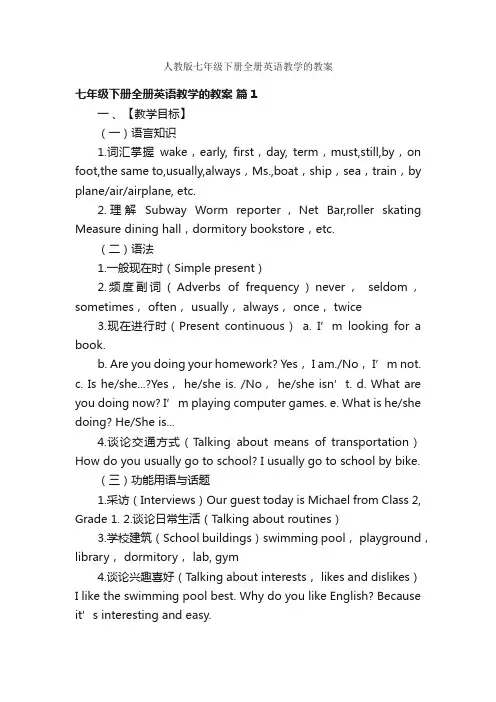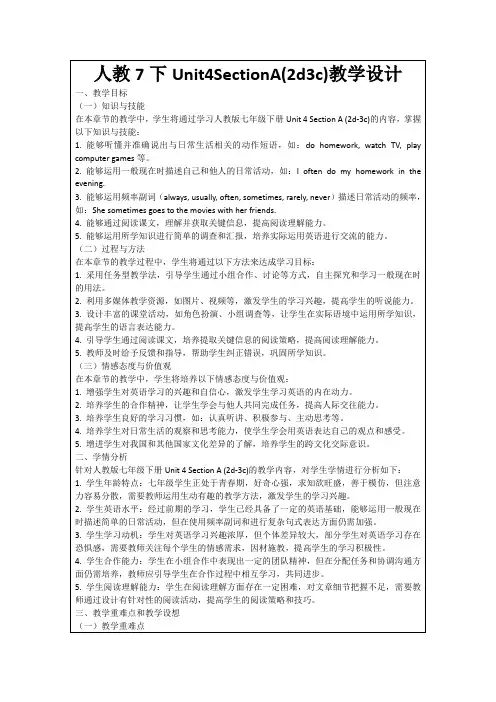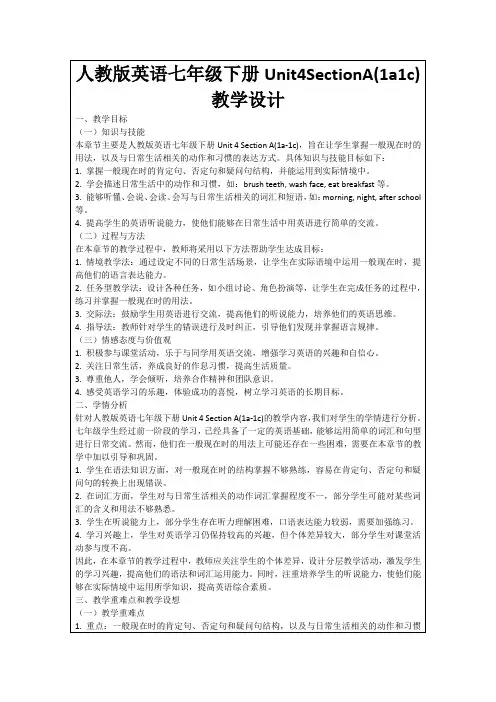人教版初中英语七年级下册教案
- 格式:doc
- 大小:72.00 KB
- 文档页数:4


人教版七年级下册全册英语教学的教案七年级下册全册英语教学的教案篇1一、【教学目标】(一)语言知识1.词汇掌握wake,early, first,day, term,must,still,by,on foot,the same to,usually,always,Ms.,boat,ship,sea,train,by plane/air/airplane, etc.2.理解Subway Worm reporter,Net Bar,roller skating Measure dining hall,dormitory bookstore,etc.(二)语法1.一般现在时(Simple present)2.频度副词(Adverbs of frequency)never,seldom,sometimes, often, usually, always, once, twice3.现在进行时(Present continuous)a. I’m loo king for a book.b. Are you doing your homework? Yes, I am./No,I’m not.c. Is he/she...?Yes, he/she is. /No,he/she isn’t.d. What are you doing now? I’m playing computer games.e. What is he/she doing? He/She is...4.谈论交通方式(T alking about means of transportation)How do you usually go to school? I usually go to school by bike.(三)功能用语与话题1.采访(Interviews)Our guest today is Michael from Class 2, Grade 1.2.谈论日常生活(Talking about routines)3.学校建筑(School buildings)swimming pool, playground,library, dormitory, lab, gym4.谈论兴趣喜好(Talking about interests, likes and dislikes)I like the swimming pool best. Why do you like English? Because it’s interesting and easy.5.借物(Borrowing things)How long can I keep it? Two weeks.6.新闻(News)、海报(Poster)Attention,please! Here is the news.7.谈论学校活动、科目和时间表(Talking about school activities,subjects and timetable)8.谈论学校生活(Talking about school life)(四)能力培养【听】能听懂谈论校园生活中比较熟悉的话题,识别主题,获取主要信息。

人教版2024七年级英语教案一、教学目标。
1. 语言知识目标。
- 学生能够掌握七年级英语课本中的重点单词、短语和句型结构。
- 理解并正确运用一般现在时、现在进行时等基础语法知识。
2. 语言技能目标。
- 听:能听懂与课本话题相关的简单对话、短文,获取关键信息。
- 说:能够用英语就日常话题(如家庭、学校生活、兴趣爱好等)进行简单的交流,语音、语调基本正确。
- 读:能读懂简单的英语文章,理解文章大意,并掌握一定的阅读技巧(如略读、扫读等)。
- 写:能够写出简单的句子和短文,描述人物、事物或事件,语法正确,书写规范。
3. 情感态度目标。
- 激发学生学习英语的兴趣,培养积极的学习态度。
- 通过英语学习,了解不同文化背景下的生活方式和风俗习惯,拓宽国际视野,增强跨文化交际意识。
4. 文化意识目标。
- 了解英语国家中与课本内容相关的文化知识,如西方的家庭文化、学校文化等。
二、教学重难点。
1. 教学重点。
- 重点单词、短语和句型的学习与运用。
- 基础语法知识的理解与掌握,如一般现在时的第三人称单数形式、现在进行时的构成和用法等。
2. 教学难点。
- 一般现在时和现在进行时在实际语境中的准确运用,尤其是两者的区别。
- 一些英语文化背景知识的理解与运用,如何将文化知识融入到语言学习中。
三、教学方法。
1. 情景教学法。
- 通过创设各种真实的语言情景,如家庭场景、学校场景等,让学生在情景中学习和运用英语,提高语言实际运用能力。
2. 任务驱动法。
- 布置各种学习任务,如小组对话、角色扮演、短文写作等,让学生在完成任务的过程中学习语言知识,培养合作学习能力和自主学习能力。
3. 交际教学法。
- 鼓励学生用英语进行交流互动,在交际中提高口语表达能力和跨文化交际能力。
四、教学过程。
(一)导入(5分钟)1. 播放一段与七年级英语课本主题相关的英语视频,如关于学校生活的动画片段。
2. 提问引导:- What can you see in the video?- Do you have a similar experience in your school?(二)知识讲解(20分钟)1. 单词学习。

新目标人教版英语七下全册教案(全英文版)Unit 1 Wheres your pen pal from?Language goals:•In this unit students learn to talk about countries, nationalities and Ian guages.•Ask and tell where people live.New languages:•Where's he / she from?•He / She is from Australia / England / China / France / Singapore / Australia. •Where does he / she live? He / She lives in Sydney.•What language do you speak? I speak English.•What's your / his / her favorite subject?•My / His / Her favorite subject is English.•Does he / she have any brothers and sisters? Yes, he/ she does. / No, he / she doesn't.Difficult points:1. Liste ning for the in formation about cou ntries, natio nalities and Ian guages. Write an e-mail about on eself. Describe the new stude nts in class.2. Where questions with fromWhere questions with liveWhat questi onsTeaching aids:• A tape recorderTeaching periods:•Period 1:Section A 中1a, 1b, 1c•Period 2:Section A 中2a, 2b, 2c, 2d•Period 3:Section A 中3a, 3b, 4•Period 4:Section B 中1,2a, 2b, 2c•Period 5:Section B 中3a, 3b, 3c, 4•Period 6:Self CheckPeriod 1Teaching aims:1. Teach vocabulary words.2. Target Ianguages:Where's your pen pal from?He is from Australia.3. Enable the students to learn to talk about nationalities.4. Help the students learn how to talk about nationalities.Teaching procedures:Step 1. Free talk2 Say: Do you have any friends? Where is she from?Help the students make the same sentences and give them more chances to say.Step 2. Talking about the picture (1a)Hold up the picture on page 1 and point at the map. Ask students toread the picture.Ask some of you to read them aloud to the class. Make the studentstalk about where people are from.Say: Du Chuan, where is your pen pal from?Ask the students to read the conversations in the picture.Step 3. Listening (1b)Point to the numbered list of words and play the recording for a secondtime.Ask the students to listen to the recording and circle the countries in 1a.Ask students to listen to and repeat after the recording and then checkthe answers.Step 4. Pair work(1c)1. Now work in pairs and read the conversations in 1a with your partner.You can talk about your own pen pal.2. Ask the students to look at their own clothes and the things in theirbackpack. Ask and answer questions about where they are from.Homework1. Ask the students to practice talking about where people are from and make up real dialogues.2. Learn the words in this unit (on page 115) by heart.Period 2Teaching aims:1. Learn the vocabulary words and useful expressions.2. Target languages: Where does he live? He lives in Toronto.3. Let the students learn to talk about where people live.4. Help the students learn how to talk about where people live.Teaching procedures:Step I.StepI RevisionCheck the homework. And then ask several students to answer questi ons.Say: Where are you from? Do you have a pen pal? Where is your pen pal from?Step 2. Presentation (2a)Put a map of the world on the blackboard.Say: What's the meaning of capital? Can you guess? Help them to answer.Write Australia, the United States, Canada, France, and Japan on theleft of the blackboard. And write Sydney, New York, Paris, Toronto, andTokyo on the right of the blackboard. And the teacher reads them aloudand asks students to repeat.Then ask students to match the cities with the countries.Step 3. Talk about countries and citiesAsk the students to work in pairs, asking about the cities and the countries.Say: Now work in pairs and ask where the city is. For example, the firststudent asks "Where is Beijing?” the second student answers “It's inChina."Then tell the students to ask question about Chinese cities.Step 4. Listening (2b, 2c)Tell the students to read the list of countries and cities in 2a.Say: Now let's look at the list of countries and cities in Activity 2a. I will ask some students to read them aloud to the class.Call the students' attention to the chart in 2c.Tell the students to listen to the conversations in Step 4 again to complete the chart.Step 5. Pair work(2d)Ask the students to read the conversations in the bubble. Then askthem to talk about the in formation in the chart in 2c.Then ask the students to work in groups and make up new dialogueswith their own information.Step 6.GrammarfocusReview the grammar box.Say: You have to pay attention the word "from". It always follows verb be, while live comes out alone in where sentences. Now make more sentences with where, from and live.Write the following on the blackboard.Say, now work in pairs and make dialogues after the model above.Homework1. Ask the stude nts to learn the sentence patter ns in Grammar Focus by heart. Try to use them freely.2. Remember the words in this unit (on page 115).3. Make a similar dialogue according to the conversation in 2d.Period 3Teaching aims:1. Teach vocabulary words.2. Target Ianguages: What Ianguage does she speak? She speaks English.3. Enable the students to learn to talk about what Ianguage people speak.4. Help the students to learn how to talk about what language people speak.Step 1. Free talkSay, Morning, boys and girls. Nice to see you again. Do you remember we have learned about how to ask where people are from and how to ask where people live? Now I want some of you to answer my questi ons.(Turn to a student.)Where are you from?Give more students chances to speak in class.Step 2. Presentation (3a)Say: Do you know the meaning of "Ianguage"? Listen: Tim is from England and he speaks English. So English is his Ianguage. I'm fromChina, so Chinese is my language .Now look at activity 3a.on page 3.Read the instructions to the class. Ask students to work in pairs as theyanswer the questions.Show the flowing and ask the students to make conversations after themodel.Step 3. Pair work (3b)Ask the students to pay attention to the conversation in Activity 3b.Say, Read the dialogue by yourselves. Then I will ask some pairs to act out the dialogue in class.Show a map of the world. Ask students to work in pairs.Step 4. Quiz(4)Ask the students to look at activity 4 then work in pairs and do the quiz.HomeworkAsk the students to work with their friends and practice the dialogue in activity 3b.Period 4Teaching aims1. Teach vocabulary words.2. Target languages:Does she have any brothers and sisters?Is that your new pen pal?Yes, it is.3. Enable the students to learn to talk about their new pen pals.4. Help the students learn how to talk about their new pen pals.Step 1. RevisionAsk the students to make conversations talking about their new pen pal.Ask some pairs to the front to talk about their pen pals. Greet each otherand have a free talk with classmates.Talk about the persons they admire.Step 2.Match work (1)Ask the students to pay attention to the notebook page with the countries listed.Ask the students to write the letter of the correct country in the box next to the title of each Ianguage textbook on the desktop.Step 3. Listening (2a, 2b)First, read the instructions and tell the students to read the conv ersati on bubbles.Check the answers. Then ask the students to read the questions again.Ask the students to fill in the chart.Give students 1 minute to finish the task. Check the answers with the stude nts.Then play the recording again and ask the students to repeat.Step 4. Pair work (2c)Ask two students to work in pairs, practicing the questions in activity 2a.Then tell the students to practice dialogues similar to the dialogue inactivity 2a in pairs. They can use their own names.HomeworkAsk the students to make up similar dialogues using the following words: Sam, the Unites Sates, New York, a brother and a sister, English and French.Period 5Teaching aims1. Teach vocabulary words.2. Target languages:I think China is a very interesting country.I like going to the movies with my friends and playing sports.My favorite subject in school is P.E.It's fun. / It's too difficult.3. Enable the students to write a pen pal letter.4. Help the students learn how to write to a pen pal.Step 1 .Warming upSay, Do you have a pen pal? Whafs his name? Does he have any brothers and sisters? What Ianguage does he speak?Then ask the students to work in pairs to talk about their pen pal.Step 2. Reading (3a)Ask the students to read the letter on page 5.Point the four questions beneath the letter.When the students finish reading the letter, ask the four questions orally and ask them to answer orally.Ask the students to retell the letter, using their own words.Step 3. Reading and writing (3b)Ask the students to pay attention to the letter from Tom King.Point out the blanks in the letter and the information card on the right.Correct the an swers. Then draw the in formation card on the blackboard and then ask the students try to retell the letter.Step 4. WritingAsk the students make their own information card.After they are finished, ask several students to read their e-mails in class.HomeworkAsk the students to choose one of the following tasks as homework.1. Show a name card to the students and ask them to write something about it.2. The students change their information card with their partner and writesomething about their partner.Period 6Teaching aims:1. Teach vocabulary words.2. Enable the students to describe the new students in the class.3. Help the students learn to describe the new students in the class.Teaching procedures:Step 1. RevisionPractice talking about one of the students.Say, Take out your information cards. And change it with your partner.Read it carefully and make up an oral practice, talking about yourpartner.Step 2.Key word checkAsk the students to read all the words in this part.Say: In learning to talk about where people are from, you learned many words on the topic. Now read and check the words you know in 1 on page6. Then say a sentence with each of them.Step 3.Vocab-BuildersAsk students to write five new words in their Vocabulary-Builder on page 112. After they are finished, ask two students to write their words down on the blackboard. And ask them to read the words and the whole class repeat. And tell the whole class to remember them after class.Step 4.WritingLet the students pay attention to the pictures.Say, Look at the picture of Sally. How old do you think she is? Where do you think she is from? What language do you think she speaks? What do you think she likes? What do you think she dislikes?The same step goes with Jim and Julie.After a few minutes, ask some students to read their descriptions to the class.Step 5.SpeakingAsk the students to do an oral practice about the new classmates.Say, There are several new students in our class this term. Who do youlike best? Why do you like him or her? Please tell us. First you can tellyour partner.Ask some students to present their work to the class.Step 6. Just for Fun!Ask all students to read the conversation.Let the students practice in pairs.HomeworkAsk the students to summarize what they have learned in this unit and prepare for the next unit.Unit 2 Where is the post office?Language goals:•In this unit students learn to talk about asking for and give directions on the street.New languages:•Excuse me, is there a bank near here?•Yes, there is. It's on Center Street.•Where is the pay phone?•lt*s across from / next to / in front of / behind the library.•lt*s between the post office and the library.•Just go straight and tum left.•Turn left on First Avenue.•Take a walk through the park on Center Avenue.•There is a clean / dirty park near my house.Difficult points:1. Listening for the information of the names of the neighborhoodRead the tour guide and an e-mail from a friend you're going to visitWrite the dialogues about asking the way and giving directions.2. Where questions.Affirmative statementsPrepositions of placeTeaching aids:• A tape recorder•Some picturesTeaching periods:Period 1: Section A1a, 1b, 1cPeriod 2: Section A2a, 2b, 2cPeriod 3: Section A3a, 3b, 4Period 4: Section B 1a, 1b, 1c, 2a, 2b, 2cPeriod 5: Section B 3a, 3b, 3c, 4Period 6: Self CheckPeriod 1Teaching aims:1. Teach vocabulary words.2. Target Ianguages: Is there a bank near here? Yes, there is. It's on CenterStreet.3. En able the stude nts to ask for and give di recti ons on the street.4. Help the students to ask for and give directions on the street.Teaching procedures:Step 1. Warming upShow three pictures prepared before class to the students. There is acat in a box in picture 1. There is a cat on a box in picture 2. There is acat under the box in picture 3.Then ask some students to ask and answer these questions.Step 2.Match work (2a)Ask the students to read the picture and the words in the numbered list.Ask the students to match each word or phrase on the list with one of the pictures.Then check the answers.Present the new sentence patterns.Then ask the students to read the dialogue in the picture.Step 3. Listening (1b)Ask the students to listen to the conversations and circle the places in 1a.Change the roles and do the same again.Then students ask and answer without the help of the recording.Step 4. PracticePoint to the different locations shown in the picture. Ask different students to name each one.Then point to more locations and let the students to practice more.Homework1. Practice the conversation in the picture on page 7.2. Learn the new words and phrases in this period by heart.Period 2Teaching aims:1. Learn the vocabulary words and useful expressions.2. Target languages:The pay phone is across from the library.The pay phone is next to the library.The pay phone is between the post office and the library.The pay phone is on Greet Street.The pay phone is in front of the library.The pay phone is behind the library.3. Enable the students to talk about the position of a place.4. Help the students to talk about the position of a place.Teaching procedures:Step 1. Revision and warming upCheck the homework by talking about the pictures on page 7 with thestudents or prepare some other pictures with different buildings in itand let the students practice asking and answering questions about theplaces.Ask the students to practice more.Step 2. Presentation (2a)Introduce the items across from, next to, between, in front of, behind and on.Draw the following picture on the blackboard.Park 3 Centre StreetEncourage or help the students to answer: It's across from the library.The same way goes with next to, on and in front of.Ask the students to match each sentence with one of the pictures.Then ask the students to read the six sentences and match thesentences the pictures.Check the answers.Step 3. Listening(2b)Review the buildings and street names in Activity 1a and the six sentences in 2a.The read the six sentences in 2b to the class.Ask the students to listen to the recording and fill in the blanks.Play the tape. Check the answers.Step 4. Practice (2c)Ask the students to repeat the conversations after the recording.Ask the students to do the Pair work asking and answering questions about the places in 1a.Step 5.Grammar FocusAsk the students to read the sentences in the grammar box aloud. The ask them to answer the following questions. Explain some Ianguage points if the students can't understand.Homework• Ask the students to practice talking about their neighborhood in pairs.Period 3Teaching aims:1. Teach vocabulary words.2. Target Ianguages:Just go straight and turn left.It*s down Bridge Street on the right.Ifs next to a supermarket.3. Enable the students to talk about the neighborhood.4. Help the students to talk about the neighborhood.Teaching procedures:Step 1. RevisionLet the students look at the picture in activity 1a. And ask some studentsto answer some questions in order to check the homework.Say, Is there a library near here? Where is it? Is there a bank near here?Where is it?Put up the picture of activity 2a on the blackboard and ask them to makeconversations.Step 2. Presentation (3a)Guide the students to guess the meanings of the three traffic signs. Show the pictures and ask some questions about the pictures.Then ask the students to hold up their left hands and then their right hands to practice “left” and "right".Point to the picture and let the students read the conversation.Ask the students to read the conversations. Then ask them to find Paul and Nancy in the picture.Ask the students to role play the conversation then point out the place that Paul wants to get to.Step 3. Complete the conversations (3b)Ask the students to make conversations and answer the questionsbelow each picture.The students point out the place in the picture. And write down theanswers on the line in the pictures. Or ask a pair of students to say theconversation, the others point to the speakers' place.Step 4. GameAsk the students to look at the picture in Activity 1a and name all thebuildi ngs.Ask some students to read the conversation in the picture in Activity 4.And then explain the instruction to the student.Then ask some groups to present their work.Homework• Ask the students to make a similar conversation to that in Activity 3a.Period 4Teaching aims:1. Teach vocabulary words.2. Target languages:Is there a big supermarket near your house?Yes, there is.There is a big supermarket.No! There is a small supermarket.3. Enable the students to describe the neighborhood.4. Help the students to describe the neighborhood.Teaching procedures:Step 1. RevisionCheck the homework by asking the following questions.Say, Look at the picture in activity 3a. Suppose you are standing nearthe building on the side of New Street. Please answer my questions.Excuse me. Is there a pay phone in the neighborhood?Ask another student to answer questions.Give more students chances to practice this dialogue.Step 2.Match work (1a)Bring in some objects or pictures to the students. (Two rulers, one is old, the other is new. Two boxes, one is big and the other is small. Two bottles, one is clean and the other is dirty. Two pictures of a street, one is busy and the other is quiet.)Say, Look at the rulers, please. Can you find the differenee between them?Yes. This one is old. (Show the old ruler.) And this one is new. (Show the new ruler.) Do you understand old and new?Ask the students to talk about the picture.Point to each half of each picture and ask about the differenee between the halves.Go on with the other pictures to teach the language items. Ask thestudents to match the words with the pictures.Step 3. Pair workCall attention to the conversation in the picture.Then ask the students to work in pairs and take turns asking each other questions about the things on the list of phrases in activity 1a on page 7.Step 4. Listening (2a, 2b)Ask the students to listen to the tape and circle the places in 1a.Say: Now please listen to the tape again. Listen to it and draw the places in Michael's neighborhood on the street map. Just listen.Play the recording.Play the recording again.Then have some students show their completed drawing to the class. Step 5. Pair workAsk the students to work in pairs talking about drawings to the class. Then ask some pairs to present their dialogues to the class.Ask the students to work in pairs, draw a map of their own neighborhood and practice asking and answering questions about the places they live in.Homework• Ask the students to make similar conversations to that in Activity 1 b.Period 5Teaching aims:1. Teach vocabulary words.2. Target languages:Turn left on First Avenue and enjoy the city's quiet streets and small parks.Take a walk through the park on Center Avenue.This is the beginning of the garden tour.Bridge is a good place to have fun.3. Enable the students to write a tour guide and draw the rout to somewhere.4. How to write a tour guide and draw the rout to somewhere.Teaching procedures:Step 1. RevisionCheck the homework by asking about the students neighborhood.Ask the students to work in pairs.Ask the students to work in pairs.Then ask some pairs to present their conversations to the whole class. Step 2. Reading (3a, 3b)Ask the students to read the tour guide.Divide the whole class into four groups to have a quiz.Tell the students to keep these words down and make at least twosentences with each word after class.After that ask the students to look at the pictures and fill in the blanks for this tour guide.Step 3.WritingAsk the students to write a tour guide with the students.Names of buildings and locations.Description wordsWords that talk about positions.Words that talk about di recti ons.Step 4. Pair work (4b)Learn to draw a picture of neighborhood. First ask the students toanswer the questions according to the pictures.Then ask the students to draw a picture according to the following conversati on.Then ask students to present their drawings to the whole class.Homework1. Ask the students to talk about the street and buildings in their own neighborhood.2. Ask the students to make sentences with the description words they keptdown in the class.Period 6Teaching aims1. Teach vocabulary words.2. Target Ianguages:I know you are arrivi ng n ext Sun day.Let me tell you the way to my house.I hope you have a good trip.3. Enable the students to write about the neighborhood.4. Help the students to learn how to write about the neighborhood.Teaching procedures:Step 1. RevisionCheck the homework by asking and answering some questions.Give more students chances to practice.Step 2.Key word check(1)Ask the students to check the words they know.Then ask the students to do the some exercises.Step 3.Vocab-Builders (2)Expand the students' vocabulary.After that ask the students to share their list with other students.Step 4. ReadingAsk the students to read the letter and draw the rout on the map.Ask the students to change the letter into a telephone conversation.Let the students pay attention to the pictures.Say, Look at the picture of Sally. How old do you think she is? Where do you think she is from? What language do you think she speaks? What do you think she likes?What do you think she dislikes?The same step goes with Jim and Julie.After a few minutes, ask some students to read their descriptions to the class.Step 5. Just for Fun!Call attention to the conversation in the cartoons.Ask the students to read the conversation and then answer the questi ons.Homework• Ask the students to do the following:1. Suppose your frie nd is going to visit you. He does n't know the way toyour house. Write a letter to him to tell him the route from the bus stop to your house.2. Review the next unit.Unit 3 Why do you like koalas?Language goals:•In this unit students learn to describe animals and express preferences.New languages:•Let's see the pandas first.•Why do you like want to see the pan das?•Because they are very cute.•Because they*re kind of shy.•Because they're kind of interesting.•Because they are fun.•Because they are smart.•Do you like giraffes?•Where are lions from?•They are from South Africa.•The animal is ugly / beautiful / friendly / small / shy / clever / cute / scary. •She likes to play with her friends and eat grass.•She's very beautiful, but she's very shy, so please be quiet•He sleeps during the day, but at night he gets up and eats leaves.Difficult points:1. Listening for the names of animals. Listen for the description words about animals.2. Read the description words about animals. Write about the animal you know.3. why, what, where questions, because, adjectives of qualityTeaching aids:• A tape recorder•Some picturesTeaching periods:•Period 1: Section A1a, 1b, 1c•Period 2: Section A2a, 2b, 2c•Period 3: Section A3a, 3b, 4•Period 4: Section B 1a, 1b, 1c, 2a, 2b, 2c•Period 5: Section B 3a, 3b, 3c, 4• Period 6: Self CheckPeriod 1Teaching aims:1. Teach vocabulary words.2. Target languages:Let's see the pan das.Why do you want to see the lions?Because they*re cute.3. Enable the students to talk about animals.4. Help the students learn how to listen to and talk about animals.Teaching procedures:Step 1. Warming upTalk about animals using pictures.Teach new words about animals by the pictures.Step 2.Match work (1a)Ask the students to read the words and the picture, and then match thenames with the pictures a-h.Encourage or help the students to say something about the picture anddo the match work.Step 3. Listening (1b)Point to the numbered list of words in activity 1a and play the recording.Ask the students to listen to the recording and circle the countries in 1a.Play the tape and then check the answers.Ask the students to listen to and repeat after the recording and thencheck the answers.Further activity: Ask the students to do some pair work in the followingway if they can understand the listening material well.Step 4. Pair work (1c)Ask the students to make conversations in pairs.Show the following.—Let's see the pan das / giraffes / lions / penguins / dolphi ns / koalas / elepha nts / tigers?—Why?——Because they're cute / interesting / fun / interesting / smart.Say: Now please make conversations in pairs, using the animals in activity 1a and the description words in activity 1c.Homework1. Ask the students to remember the new words in this period (on page 116) by heart.2. Ask the students to practice the conversation in activity 1 c.Period 2Teaching aims:1. Learn the vocabulary words and useful expressions.2. Target languages:I like dolphins.Why do you like dolphins?Because they are kind of interesting.3. Enable the students to talk about animals and tell why they like them.4. Help the students learn to talk about animals and tell why they like them. Teachi ng procedures:Step 1. Free talk and lead-inRevise the names of the animals.Say: In last period we learnt the names of some animals. Now let's do some revision. Please look at the pictures one by one and you have to tell me the name of the animal in the picture. OK?Show the students the animal pictures one by one.Revise the conversation learnt in the last period.Give more chances to more students to practice talking about the animals and expressing why they like the animals.Step 2. Listening (2a, 2b)First ask the students to listen and fill in the chart in activity 2a.Play the recording for the first time. Ask the students to listen carefully and write down the animals.Play the tape the second time.Ask the students to pay attention to the words in the box in Activity 2b.Ask the students to pay attention to the conversation in activity 2b. After that, check the answers.Then ask the students to listen to and repeat the dialogue after therecording.After this, ask the students to practice the conversation without the help of the recording.Step 3. Pair work (2c)Ask the students to work in pairs, ask and answer about animals they know.Ask the students to practice: Why? Because they are...Step 4.GrammarfocusAsk the students to read the sentences in the grammar box and sum up the sentence structure.Practice suggest!on: Ask the students to work in groups and write down。



人教版七年级英语下册全册教案Unit1 Where is your pen pal from?Topic:Countries, nationalities, and languagesFunctions:Talk about countries, nationalities and languagesAsk and tell about where people liveStructure:Where's/Where're ...from?Where does/do ...from?What questions----What language does/do ...speak?Target language:Where is she from? She is from....Where does she live? She lives in....What language does she speak? She speaks....V ocabulary:words about countries, languagesTeaching design:The whole unit needs 5 periods, 4 for new lessons and 1 for testPeriod 1 ( 1a----Grammar Focus )Key points:Where is your/John's pen pal from? He/She is from...Where does he/she live? He/She lives in....(Homework for preview)Pre-task:Let the Ss give themselves pen pals and they should write down their pen pals' information, such as their names, countries and cities they live even the language they speak.T can give the Ss an example meanwhile T gives the different countries which can be used by the Ss. T gives the Ss Chinese words for the countries, they are following: 加拿大,法国,日本,美国,澳大利亚,新加坡,英国,中国( The Ss can look them up in the dictionary if they are new for them)The example is following:Name: Curry MurayAge: 75From(Nationality): the United StatesCity: New YorkLanguage: EnglishTeaching Steps:Key points:Where is your/John's pen pal from? He/She is from...Where does he/she live? He/She lives in....(Homework for preview)Pre-task:Let the Ss give themselves pen pals and they should write down their pen pals' information, such as their names, countries and cities they live even the language they speakT can give the Ss an example meanwhile T gives the different countries which can be used by the Ss. T gives the Ss Chinese words for the countries, they are following: 加拿大,法国,日本,美国,澳大利亚,新加坡,英国,中国( The Ss can look them up in the dictionary if they are new for them)The example is following:Name: Curry MurayAge: 75From(Nationality): the United StatesCity: New YorkLanguage: EnglishTeaching Steps:Step 1 Leading-inThe information of the teacher's own pen pal's information."I have a pen pal. His name is Curry Muray. He is from the United States.Do you have a pen pal? Where is your pen pal from? What's your pen pal's name?"Different students say the information about their own pen pals. T should choose the different countries. T writes the different countries on the Bb(both Chinese and English)Step 2 LearningSection A 1a Learn the new words on the Bb. The new words are: pen pal; Canada; France; Japan; the United States(the US/the USA/America); Australia; Singapore; the United Kingdom(the U.K./Great Britain/England)Pay attention to the pronuciation of the new words.Step 3 Listening1b Listen and circle the countries in 1a they learnedStep 4 CompetitionTwo groups of students to write the new words to see which group does better. First write down the Chinese words with looking at the English meanings, then write down the English words with looking at the Chinese meanings.(This step is a memory game. It can help the Ss consolidate the new words they learned)Step 5 Pairwork1c Practise the following conversation:---Do you have a pen pal? ---Yes, I do.---Where's your pen pal's from? ----He/She is from ....(Write it down on the Bb)First T has a conversation with one student as an example then let the Ss practise in pairs. At last let several pairs do it again in class.Step 6 Leading-inRevise the countries names with looking at the Bb. Then T writes down the city names on the Bb. Let the Ss try to find out which countries the cities are in. The city names are following:Toronto; Paris; Tokyo; New York; Sydney; Singapore; London;Step 7 Learning2a Learn the city names together with the whole class just like Step 2 2b Listen and circle the cities and countries2c Listen and complete the chartHave a similar competition to consolidate the new words in this part.Step 8 PairworkT has a conversation with one student like the following:---Do you have a pen pal? ---Yes, I do.---What's your pen pal's name? ---His/Her name is....---Where is your pen pal from? ---He/She is from...---Where does he/she live? ---He/She lives in....(Write it down on the Bb)Let the Ss practise after the T's example in pairs then several pairs do it in class.Step 9 ExerciseMy pen pal is from Australia.(划线提问)John's pen pal is from Japan. (划线提问)He lives in Paris. (划线提问)Homework:Read and copy the new words .Copy the sentences in Grammar FocusMake up the questions about Jodie in 2c The questions are:Does Jodie have a pen pal? Where is Jodie's pen pal from? Where does he/she live? What's his/her name?(This one can be chosen by themselves) Unit 2 Where's the post office?Language goalThis unit students leam to ask for and give directions(方向) on the street. New languageIs there a bank near here? Yes, there's a bank on Center Street, Where's the supermarket? It's next to the library.Is there a pay phone in the neighbhood?Yes, it's on Bridge Street on the right.locations in the neighborhood such as post office, hotel,video arcade.Descriptive words such as new, old, dirty, clean.Descriptions of location such as across from, next to,BetweenRecycled languageWhat are you doing?Do you want to ...?Section AAsk two rows of three students each to stand facing each other in the front of the classroom. Point to students standing in front and ask the class to repeat the questions and answers.Example 1Teacher: Where'sYang Li? (Point to two students standing beside each other.) Yang Li is next to Li Peng.Example 2Teacher: Where's Zheng Wen? (Point to two students in different lines facing each other.)Zheng Wen is across from Sheng Lin.Example 3Teacher: Where's Lin Jiahui? (Point to one student standing between two other students.) Lin Jiahui is between Sheng Lin and Li Dai.la This activity introduces the key vocabulary.Focus attention on the picture. Ask students to name as many of the places they see in the picture as they can.Then name all the places and ask students to repeat.Point out the numbered list of words. Say each one and ask students to repeat.Then ask students to match each word or phrase on the list with one of the pictures. Say, Write the letter of each place in the picture next to the correct word or words on the list. Point out the sample answer f.Check the answers.1b This activity gives students practice listening to and understanding the target language.Point out the buildings and other locations in the picture. Say the name of each one to the class.Say, Now I will play recordings of three conversations. Listen carefully and circle the picture of each place you hear on the tape..Play the recording the first time. Students only listen.Play the recording a second time. This tine ask students to listen and circle the items they hear on the picture.Correct the answers.These items should be circle:video arcade, post office, supermarket.Tapescript(录音稿)Convernation 1A: Is there a video arcade on Fifth Avenue?B: Yes, there is.Conversation 2A: Is there a post office near here?B: Yes, there is. There's one on Bridge Street.Conversation 3A: Is there a supermarket on Center Street?B: No, there isn't.1C This activity provides guided oral practice using the target language.Point to the different locations shown in the picture.Ask different students to name each one. If necessary,say the name and ask the student to repeat.Point to the question and answer In the example conversation and ask a pair of students to read the conversation to the class. Ask other pairs of students to repeat the activity if you wish.Ask students to work in pairs. Say, First one person asks a question and then the other person takes a turn.Demonstrate(示范)the activity. Point to the picture and ask. Is there a post office near here? Then choose a student to answer. Guide the student to say, Yes,there's a post office on Bridge Street.As students work, move around the room and check progress(进展情况). Help students understand how to locate things on the map, if necessary.Ask several students to say some of their questions and answers for the class.教学后记:教学方法有问题?教了这么多年的英语,总幻想有一种方法,能让学生轻轻松松把英语学好。


最新2023年部编人教版英语七年级下册教案(全册)第一单元:认识新同学教学目标:- 研究并复关于个人信息的表达方式,如姓名、年龄、国籍等;- 研究并掌握相互问候和自我介绍的常用表达;- 能够用简单句子互相介绍自己和他人。
教学内容:1. 单词及词组- 名字(name)、国籍(nationality)、年龄(age)、学校(school)、家庭(family)、班级(class)、手机号码(phone number)、电子邮箱(email address)、问候语(greetings)、自我介绍(self-introduction)2. 语法- 一般现在时的肯定句和疑问句教学流程:1. 导入新课,介绍并复相关单词和词组。
2. 模仿示范,带领学生用一般现在时谈论个人信息。
3. 练相互问候和自我介绍。
4. 进行小组活动,让学生互相介绍自己和同学。
5. 梳理语法知识,引导学生理解一般现在时的构成和用法。
6. 进行语法练,巩固学生对一般现在时的掌握。
7. 总结本节课的内容,布置相关作业。
教学资源:- 《最新2023年部编人教版英语七年级下册》教材- 多媒体课件- 黑板和白板- 学生练册注:以上内容仅为简要介绍,具体的教案细节请参考教材及教师指导手册。
以上是《最新2023年部编人教版英语七年级下册教案(全册)》第一单元的简要内容。
本单元旨在帮助学生复习和掌握关于个人信息的表达方式,以及相互问候和自我介绍的常用表达。
通过多种教学活动和练习,学生将能够用简单句子互相介绍自己和他人,并掌握一般现在时的构成和用法。
详细的教案内容请参考教材及教师指导手册。

(此文档为word格式,下载后您可任意编辑修改!)Unit 1 Where’s your pen pal from?一、单元教材分析本单元的中心话题是pen pals。
主要语言功能项目是talk about countries, cities and languages。
语法结构为Where...from; Where (iv)and what language…speak。
先以Activity1复习语言与国家的配对练习入手,Activity2a, 2b一个综合的听力训练来展示学生的听力能力,并以听力内容为基础,通过Activity2c中假设的两人对话操练来培养学生的交流能力,同时也引导学生多沟通与多交流。
Activity3a是一篇email形式的阅读文章,并有相关问题由学生在阅读后进行回答Activity3b 是根据提供的信息进行填空的写作练习,Activity3c是一篇模仿写作,让学生给自己的笔友写一封关于本人信息的email。
我在各课时教学中设计各种各样的小活动,通过Discussion,Classifying,Guessing等不同方式让学生掌握本单元的知识点,用学会的知识与外国的笔友自如的交谈是学习本单元的目的。
二、教学目标分析1、语言目标a. 重点词汇:Countries: Canada, China, France, Japan, the United States,Singapore, Australia, The United Kingdom,Paris.Cities: Sydney, New York, Toronto, Toyo, London Languages: English, French, Japanese, Chinese.b. 重点句型:-Where…from? -She’sHe’s from…-Where does…live? -SheHe lives in …-What language does she A 1a—2dPeriod 2 Section A 3a—Section B2cPeriod 3 Section B 3a---3cPeriod 4 Summing up Section A and B and the grammar.五、教学过程设计The First PeriodTeaching aims:1.Learn to express the main countries and cities.2.Know something about the countries.3.Master where- sentence structure.Key points:1. Words: pen pal, Australia, Japan, Canada, France, the United states,Singapore, the United Kingdom, country, Sydney, NewYork, Paris, Toronto, Tokyo world2.Sentences: -Where is your pen pal from? -He’s from Australia.-Where does Paris-Where is John’s pen pal from ?Teaching aids:Some cards with cities and countries.Teaching procedures:Step 1.Lead—in (1a&2a)First greet the students. Then teacher begins the topic with the Spring Festival. Do you use the fresh pictures through computer to teach the students names of countries, cities. Divide the students into groups, then show the flags and pictures, let them guess the names of countries and cites. At last finish 2a on page2. 通过这个环节,教师完成本单元的新单词的导入,通过提供给学生每个国家的地图,让学生猜出国家名称及相应的城市,学生能有意识的记忆国家及城市的名称,并为整节课任务的完成奠定最基本的词汇基础。

Unit 1 教学设计Title Unit 1 Can you play the guitar?Teaching aimsKnowledgeWhat club do you want to join?I want to join the … club.Can you …?Yes, I can. / No, I can’t.Can you … well?Yes, I can. / No, I can’t.Why do you want to join our … club?Because I like … / Because I can …What else can you do?I can …Skills1. Learn to talk about what they can do. Tell otherstheir strong points.2. Through practice, learn to ask others what theycan or can’t do.Emotionsand CultureTo find a job is not so easy. The chances only work forthose who are well prepared.Key wordsEnglish club, music, art, sport, chess, English poem, sing, dance, play the guitar, violin, piano, flute, trumpet, drum, paint, draw, swim, run, play chess,Chinese chess, …Important & difficult points What club do you want to join? What else can you do?Why do you want to join our club? We want … to join our club.SolvingmethodsTask-based learningTeaching Process 1. Review the words and expressions. Ask and answer.2. Want advertisements show3. Students’ example----an interview.4. Interview5. Show the interviews.6. Brief discussion7. Show the results and fill the forms out.8. Homework.TeachingaidsComputer, real object projector.Teaching proceduresTask 1 ReviewStep 1Teacher’s Activity: Lead in. “In our school there’re five clubs: English club, music club, art club, sport club and chess club. Today, these clubs come to our class and want some of you to join them”. “Do you want to join these clubs?”Students’ Activity: Listen to the teacher and answer the questions.Step 2Teacher’s activity: ask students questions:What club do you want to join?Can you…? Can you … well?Students’ activities: answer the questions.Step 3Teacher’s a ctivity: ask students questions:What club do you want to join?Can you…? Can you … well?Why do you want to join the … club?Students’ activities:Answer the questionsStep 4Teacher’s activity:ask students questions:What club do you want to join?Can you…? Can you … well?Why do you want to join the … club?What else can you do?Students’ activities:Answer the questionsTask 2 Want Advertisements ShowTeachers activity: Ask the interviewers to show their want advertisements. Ok, now the interviews are going to begin. Before the interviews, these clubscome to the dais and show their want advertisements show. Welcome!Students’ activities: The int erviewers applaud for the clubs. And the interviewers show their advertisements to the class one by one.Task 3 What can you say in interview? Show an example.Teacher’s activity: “Do you want to join these clubs? Do you know what you can say in your in terviews? Ok, I’d like to ask two of the English clubs to show an example to you.” and show the slide.Students’ activities:V olunteers in English club come to the dais and show the words and expressions. The interviewer shows the form they are going to use and fill it out according to their conversation. The other students listen to them carefully and know what to do next.Task 4 InterviewsStep 1Teacher’s activity: “Now what you can say through an interview. You’re going to fill in the forms you have according to your interviews. Now it’s time forinterviews. Let’s begin.”Students’ activities: Interview. Use the words and expressions on the slide.Step 2Teacher’s activity: Walk around the classroom and see how the interviews are going onand help some of the students if necessary.Students’ activities: Do the interviews. The interviewers fill in their forms.Task 5 Show the interviewsTeacher’s activity: Ask the students to show their interviews one by one. “Ok, time is up. Now I would like to ask one pair of each club to come here and show your interview.”Students’ activities: Show their interviews one by one.Task 6 Brief discussionTeacher’s activity: “Now I’d like to ask the interviewers to have a discussion and decide who you want.” (slide show) “You may use this sentence”. When the interviewers are discussing, hand out the forms to the students.Students’ activities: A brief discussion among the interviewers. And the others get the forms.Task 7 Show the resultsTeacher’s activity: Ask th e students to show their results. “Finished? No, show youresults. Tell us who you want. You may use this sentence: Wewant … to join us because….” (slide show) “And the otherstudents, would you please listen to them carefully and take notes,OK?”Student s’ activities: the interviewers’ spokesman come to the dais and tell the whole class to listen to the interviewers and take notes. F ill in the forms they have.Task 8 Show the final resultTeacher’s activity: “Now I’d like to ask one student to come her e and show us his or her form. He or she can use this sentence.”(Slide show) … arein … club. Ask one student to come to the real object projector andshow the others his or her form.Students’ activities: Listen to the reporter carefully.Task 9 HomeworkTeacher’s activity: Slide show first. “OK, it is the end of the interviews. After class you still have two tasks. First, the new club members, you should makea new plan for your clubs and make your forms like this.” Point tothe screen. “Your activities, time, place and the names of yourgroup members. Second, some of you haven’t found your clubsyet. So after class, you should go to some other clubs and haveinterviews with them. Find yo ur own clubs, OK?”Students’ activi ties: Listen to the teacher. Take notes if possible.Writing on blackboardUnit 1 Can you play the guitar?1. Review. Ask and answer.2. Want advertisements show3. Students’ example----an interview.4. Interview5. Show the interviews6. Brief discussion7. Show the results and fill the forms out.8. Homework.Forms for tasksForm 1 For Engli sh ClubName: ___________Club: ___________1. Can you…?²Speak English²Read in English²Sing English songs²Write English poems²Write English plays2. Can you …well?²Speak English²Read in English²Sing English songs²Write English poems²Write English plays3. Why do you want to join our club?_______________________________________________ 4. What else can you do?_______________________________________________ Form 2 For Music ClubName: ___________Club: ___________1. Can you … ?²Sing²Dance²Play the piano²Play the drum²Play the violin²Play the trumpet²Play the guitar²Play the flute2. Can you … well?²SingForm 3 For Art Club²Make oil painting²Make Chinese painting²Make flower painting²Make fruit paintin g3. Why do you want to join our club?_________________________________________ 4. What else can you do?_________________________________________ Form 4 Sport ClubName: ___________Club: ___________1. Can you … ?²Run²Swim²Play basketball²Play baseball²Play volleyball²Play soccer²Play tennis²Play ping pong²Play bowling²Play badminton2. Can you … well?²Run²Swim²Play basketball²Play baseball²Play volleyball²Play soccer²Play tennis²Play ping pong²Play bowling²Play badminton3.Why do you want to join our club?_________________________________________ 4. What else can you do?_________________________________________ Form 5 For Chess ClubName: ___________Club: ___________1. Can y ou … ?²Play chess²Play Chinese chess²Play I-go²Play black and white chess²Play flight chess²Play go bang²Play Animal chess2. Can you … well?²Play chess²Play Chinese chess²Play I-go²Play black and white chess²Play flight chess²Play go bang²Play Animal chessForm for task 9Teaching Plan for U2Teaching aims: Learn to talk about routines; learn to ask about and say times.Grammar: Simple present tense*Structure:what time questions; when questions; adverbs of frequency; That’s a funny time for breakfast(that’s a+ adj.+ time+for sth.); It’s not good for her (it’s + adj. + for sb/sth..)*Vocabulary: refer to the wordlist on P121-122Phrases: get u p, get dressed, brush one’s teeth, eat breakfast/lunch/dinner, take a shower, do one’s homework, radio station, go to work, at night, on school days, best friend, on weekends, take a walk, taste good, either…or…, lots of*Writing: learn how to write about one’s daily routines.*Sentences for writing:①I have a very healthy life.②In the morning, I get up at eight. Then I go to school at eight thirty.③I don’t have much time for breakfast.④After school, I either watch TV or play computer games.⑤At ten thirty, I brush my teeth and then I go to bed.Use the following words to write a paragraph (at least 80 words): life, never, either, exercise, quick*Passage to recite: P11 2b the first paragraphTeaching procedures:Period One:Teaching material: P7, P8 2a, 2b, 2c, P91. Lead in:2. P7 1a Match the activities with the pictures. And then put the activities into the correct order according to your own experiences.Language points:1) dress v. get dressed/dress sb. n. dress 连衣裙pl. dresses2) brush v. brush teeth 第三人称单数brushes3. P7 1b Listen and match the times with the actions. Draw lines from the clocks to the pictures.4. Pair work: Look at the picture on P7, ask and answer about Rick’s day. 操练第一,第二人称e.g. A: What time do you usually take a shower? 第一遍可让学生看图片,根据提示填空,B: I usually take a shower at six forty. 待熟练后让学生看图片完成整个问答,不给提示5. Culture Note: People in western countries are used to taking a shower after they get up in the morning. In the evening, they like to take a bath. Jim’s family members also take a shower in the morning, but they have a problem.1) Listen once and find out Jim’s problem and how they solve this problem. P8 2a Complete the sentences;2) 2b Listen again and complete the shower schedule for J im’s family.3) Pair work 1: Look at the shower schedule. Ask and answer: 操练第三人称A: When/What time does Bob take a shower?B: He always takes a shower at five thirty.Language points:1) When 可提问具体时间和大致时间/what time 只能提问具体时间2) Adverbs of frequency: always, usually, sometimes, nevere.g. I always get up at 6 o’clock.I am never late for school. 频率副词在句子中的位置,在实义动词前,be动词后。
新人教版七年级下册全部英语教案第一单元- 课程目标:通过本课的研究,学生将能够简单地问候并介绍自己。
- 教学重点:问候语和自我介绍。
- 教学准备:课件、黑板、学生教材。
Teaching objectives- By the end of the lesson, students will be able to greet and introduce themselves in a simple way.Key points- Greetings: "Hello, how are you?"- Introductions: "My name is [name]."Teaching aids- PowerPoint slides, blackboard, student textbooks.Lesson 2: Rules at school- 课程目标:通过研究本课,学生将能够了解学校的规则和纪律,并能正确使用一些表达方式。
- 教学重点:掌握表示规则和纪律的表达方式。
- 教学准备:课件、黑板、学生教材。
Teaching objectives- By the end of the lesson, students will be able to understand the rules and discipline at school and use expressions related to them.Key points- Expressions related to rules and discipline.- Examples: "Don't run in the hallways", "Don't be late for class".Teaching aids- PowerPoint slides, blackboard, student textbooks.第二单元Lesson 3: My family- 课程目标:通过研究本课,学生将能够谈论自己的家庭成员,并使用形容词描述家人。
最新人教新目标七年级英语下册全英文教案(全册全英文)Unit 1 Can you play the guitar?教学过程♦ Step 4 Role-play1.Ask the students to read the conversation in 2d.try to find: What can Jane/ Bob do?What club do they want to join?2.Ask the students to fill in the forni.(见课件)3.Ask students to practice the conversation according to the for m・4.Ask students to perform the conversation.♦Step 5 Explain several important words and phrases.(见课件)♦Step 6 HomeworkMake a survey about what your friends can do and what club your friends want to join. 板书设计Unit 1 Can you play the guitar教学过程Example:In my group,Li Lin can do kung fii.Liu Kun can tell stories....Fm sure we will give you a good show and make you have a good time・♦ Step 6 HomeworkWrite an ad—Students Wanted for Our Learning Group・板书设计Unit 1 Can you play the guitar4.Ask students to read the passages in 2b.And then match the titles with the ads・5.Check the answers・6.Who fits the job? Match each person in 2a with an ad in 2b.Write A.B and C.(见・课件)7.Check the answers・♦Step 5 Explain important points.♦Step 6 HomeworkWrite a letter to your. teacher.Tell him/lier what you can do for school concert・板书设计课堂练习I •根据汉语意思完成句子1.你能帮我学英语吗?____ you help me ________ English?2.你善于和老人相处吗?____ you ______________ old people?Unit 1 Can you play the guitar(3)hclp⑷be good at/witli/for的用法与区分Work on Self Check 3Ask several students to show their works.♦ Step 5 HomeworkWrite a poster:Artist Wanted for Art Festival.板书设计课堂练习I •单项选择1 ・ Peter __ play soccer・A.can alsoB.also canC.can tooD.too can2.___ you good ______ c hildren?A.Are;forB.Is;in.C.Are;atD.Are;with3.Please call Mr.White ____ 589-267.A.inB.atC.onD.with4.― an you sing or swim?A.YesJ can swimB.NoJ can't swimC.YesJ can singD.I can sing5.___________________________ We want two good actors our school show.Unit 2 What time do you go to school?Keys:(l )From 12:00 at night to 6:00 in the morning. (2)At eight thirty at night. (3) At nine. (4) At ten twenty.(5) At elev亡n o'clock.3.Ask students to practice the conversation in 2d in pairs.教学过程板书设计课堂练习I .根据句意及首字母提示完成单词I・一What t _ da you go to school?—At &00.2.1usually get u ____ at 7:00 every day.What about you?3.__________________________________ My mother bought me two red d on my birthday.4.1need a new b _____ and some new pencils to draw the picture・5.1usually take a s ____ before I go to bed・Keys: 1.time 2.up 3.dresses 4.brush 5.showcrII.用所给词的适当形式填空1. A man has twenty-eight ______ (tooth)・2.Mrs.Li _____ (dress) little Tom every morning.3.My father ______ (work) in a shoe factory.4.Mr.Wang tells us a _____ (fun) story in class.5.1do morning ______ (exercise) with my grandparents every day.Unit 2 What time do you go to school♦Step 2 Learning Grammar Focus1.Ask students to read the sentences in Grammar Focus and translate them into Chinese.,2.Explain several important points・3.Ask students to do some exercises.(见课件)♦Step 3 Writing sentences1 .Work on 3a.Ask the students to write answers or e always,usually or never.2.Ask the students to show the answers.3.Let students write something they always/usually/never do on the blackboard・4.Ask students to do an interview with three students.Find out what time they do the activities in 3c.Then give a report. For example:In our group.Li Fei usually gets up late on weekends.She gets up at...♦Step 4 Explain several important words and phrases.(见课件)♦Step 6 HomeworkWrite an article to mtrodnee your classmate's daily activities.板书设计课堂练习I .根据句意及汉语提示写单词1 .This is a big train (火车)(站)・2.Lily ____ (从不)buys green clothes.3.You don't need to go to school ______ (早地)next Monday.4.The _____ (收音M) player is very nice・5.We have lunch at twelve _______ (点钟).Unit 2 What time do you go to school教学过程♦Step 4 Explain several important points.♦Step 5 HomeworkWrite a passage about your daily life.板书设计课堂练习I .单项选择I.Can you help us do _____ ?A.our homeworksB.our homework homeworks homework2.We go home at half _____ five ______ t he aftemoon.A.to;inB.past;atC.to;atD.past;in3.What time do you eat _____ breakfast? What do you usually have _______ breakfast?A./;/B.for;forC./;forD.for74.1 like to eat __ apples _____ pears.but not grapes・A.either;orB.neither;norC.not only;butD.or;or5.____________ The cake good.I w^nt another one・A.feelsB.tastesC.soundsD.feelsKeys:l—5BDCABII•根据汉语意思完成句子Unit 2 What time do you go to schoolUnit 3 How do you get to school教学过程♦ Step 4 Work on 2dStudent A is Jane and Student B is e the information in 2b to make conversations.A:How do you get to school?B:L・・A:How long does it take...?B:It takes...A:How far is it from...to...?Bit's about...♦Step 5 ReadingAsk students to read the dialogue in 2e and translate it into Chinese.Then ask students to role-play the dialogue. ♦Step 6 HomeworkPractice the conversation in 2c.板书设计课堂练习1.根据句意及汉语提示写单词1 Jim is not happy because he lost his _____ (自行车).2.There are always lots of people on the _____ (公共汽车).3.My aunt takes the ____ (地铁)to work every day.4.—How do you get to Beijing?—I take the ____ (火车).5.1 usually _____ (步行)to school in the morning・Keys: 1.bike 2.bus 3.subway 4.train 5.walkUnit 3 How do you get to school教学过程♦ Step 4 Make a survey 3cl.Show a chart on the screen.(2.Let students ask their classmates questions and write their names in the chart.The firs4 student to fill in all the blanks wins.3.Ask several students to show their results in front of the class・板书设计课堂练习I •单项选择l.____________ How far is from Hangzhou to Wuhan?A.thatB./C.itUnit 3 How do you get to school教学过程4.Check the answers.(见课件)①They go on a ropeway to cross the river to school.②Because they don't have a bridge over die Tiver.③Yes.he does.Because he loves to play with his classmates and he loves his teacher.④The dream is that there .is a bridge over the river.I think their dream can come true.Because all the villagers are working on it.5.Ask the students to read the passage again and complete the sentences in 2c with words from the passage・6.Check the answers・(l)difficult (2)big (3)quickly (4)afraid (5)truc♦ Step 5 HomeworkWrite a short passage about how your classmates go to school.板书设计课堂练习I •根据句意及首字母提示完成单词1.____________ Linda's h is far from her school.2.She t ____ the No.16 bus to school every day.Unit 3 How do you get to school2.F inish Self Check 2.Ask students to write at least five questions with the information in the chart.Then answer thequestions・For example:—How does Tony get to school?—He gets to school by bike・♦ Step 5 HomeworkWrite a passage with t he information in Self Check 2.板书设计课堂练习I•根据汉语意思完成句子1.Mike often _________________ (坐火车)to Beijing.2.Let's go there __________ (乘小汽车).3.My teacher ____________ (像)a friend to me.4.Mrs.Li has _________________ (—个八岁大的)daughter.5.1 eat fruit and vegetables ___________ (每天).6. _ ________ (多长时间)does it take Zhao Lei to do his homework?Keys: 1.takes the train 2.by car 3.is like 4.an eight-year old 5.cvcry day 6.How long II•根据句意,用合适的介词填空1 ・一What do you think _____ the travel?―reat.2.It is about two kilometers ____ my home _______ school.3.Thursday is ____ Wednesday and Friday.4.Jane often goes to school _____ t rain.5.___ many studentsat is easy to get to school. Keys: 1 .of 2.from;to 3.between 4.by 5.For教学反思Unit 4 Don't eat in class.教学过程2.Check the answers.(见课件)(1)It’s not to be late for class.We must be on time.(2)No.they can't.(3)No.they have to wear the school uniform.3.Let students role-play the conversation in 2d in pairs ♦ Step 6 HomeworkWrite the rules in your home.板书设计课堂练习I .根据句意及首字母提示完成单词I.It's very i __ for students to learn English well.2.We must be g _____ in the library.3.We can't eat ill the classroom but we can eat o _____ ・4.Doift a ____ late for class next time.5.Lily w _____ a red dress today.Keys: 1 .important 2.quiet 3.outside 4.arrive 5.wearsII.单项选择1.Don't be late ___ school.A.onB.forC.inD.at2.—Doni eat in the classroom.—__ ,Miss Liu.A.TlianksB.ReallyC.SorryD.Why3.We can't Jisten to music in the classroom. _____ we can do it in the hallways.A.andB.butC.soD.or4.― an I wear hats in class?—__ .but you can wear them after class・A.YesJ canB.Yes.you doC.NoJ can'tD.No,yon cant5.Rose _____ to school very early every day.A.arrivesB.getsC.reachesD.arriveKeys: 1—5 BCBDB教学反思Unit 4 Don,t eat inclass教学课题Section A (Grammar Focus-3c)教学目标【知识目标】Important phrases:wear a hat.wear a uniformImportant sentences:1 Don't run in die hallways.2.—What are the rules?—We must be on time for class・3.― an we eat in the classroom?—No,we can5t,but we can eat in the dinmg hall.4.—Docs he have to wear a uniform at school? ―Yes.he does./ No.he doesn't.5.—What do you have to do?—We have to be quiet in the library.教学重难点【能力目标】1.学会使用祈使句。
新人教版七年级英语下册教案课堂能否进行高效率授课,学生与老师之间能否做到默契配合,教师能否让一节课的内容合理分布在课堂的每一个细节,这些都有赖于教师的教案设计是否符合学生的整体情况。
下面是小编为大家精心整理的新人教版七年级英语下册教案,仅供参考。
新人教版七年级英语下册教案(一)Unit 1 Section B (3a-Self Check)教学目标:1. 语言知识目标:1) 复习询问或谈论自己或对方在某一方面的能力和特长,讨论参加某一个俱乐部。
2) 能够综合运用所学的知识,就自己的熟悉的内容来介绍自己或他人所俱有的能力及特长;3) 总结回顾一些常见的一些表达人们能力的词汇,并能进行分类记忆。
2. 情感态度价值观目标:1) 能了解自己的一些特长,并运用自己的一技之长为他人或社会做一些有益的事情。
2)新人教版七年级英语下册教案(二)教学重难点1. 教学重点:1)2)能运用自己所学的相关英语语言知识,模仿所学过的相关材料来制作简单的广告。
2. 教学难点:的广告。
新人教版七年级英语下册教案(三)教学过程Ⅰ. Warming- up and revision1. Have a dictation of the new words and expressions.2. Let some Ss retell what Peter, Alan and Ma Huan can do.3. Let some Ss to read the three ads again.Ⅱ. Presentation1. T: Who's he?Ss: He's Liu Huan.T: What does he do?Ss: (Help Ss to answer) He's a famous musician.Write the words musician on the Bb.music 音乐→ musician音乐家拓展: teach教→teacher老师Ⅲ. Practice1. T: Next week we'll have a music festival. So we need some musicians to help with the music festival. I wrote an ad the box.2.Ⅳ. Writing3. 2b或3a中的广告的样子来写。
七年级下册英语教案人教版(优秀6篇)七年级英语下册教学计划篇一一、本学期的指导思想本人在本学期的英语教学中,坚持以下理念的应用:1、要面向全体学生,关注每个学生的情感,激发他们学习英语的兴趣,帮助他们建立学习的成就感和自信心,培养创新精神;2、整体设计目标,体现灵活开放。
3、突出学生主体,尊重个体差异;4、采用任务型的教学模式,让学生在老师的指导下通过感知、体验、实践、参与和合作等方式,实现任务的目标,感受成功;5、注重过程评价,促进学生发展,建立能激励学生学习兴趣和自主学习能力发展的评价体系。
二、教材分析本书每个单元都列出明确的语言目标、主要的功能项目与语法结构、需要掌握的基本词汇,并分为A和B两部分。
A部分是基础的语言内容,B部分是知识的扩展和综合的语言运用。
对于我们学生来说,由于小学基础不好,到初中以后学起来的确有些吃力,尤其是一千多个单词的记忆和简单的语法就吓退了不少学生学习英语的兴趣。
但我们必须知难而上,坚守教师职责,实实在在为英语教学成绩而努力。
三、教学目标对英语学习表现出积极性和初步的自信心。
能尝试使用适当的学习方法,克服学习中的困难。
常用的训练活动有以下几项:(1)Daily report:值日生介绍自己、家庭成员或朋友的情况,其它学生可互相提问题,询问个人职业。
(2)Play a guessing game:用问题“what does he do?”引入任务,让学生猜测多媒体课件中人物的职业,以此激发学生的学习兴趣,并训练学生的发散思维能力。
(3)Ask the way :创设问路情景,根据实际情况telling the way,eg. I want to go the hospital 完成对话活动。
通过训练把课内的语言学习与课外的语言活动结合起来,改变了过去老师一言堂的模式,变学生为主体,课堂主要是提供了一个学生获取知识的平台。
学生在活动中主动地获取知识。
四、具体实施方案1、加强词汇教学。
人教版七年级英语下册教案Unit 1 Can you play the guitar?单元目标与要求1、学会谈论能力2、谈论喜好和意愿3、询问别人在乐器方面所具备的才能。
4、谈论某人在音乐方面所具备和不具备的才能。
5、仿写招聘广告language points(语言点)1、要求掌握以下句式(1)---Can he/she paint/speak English?---Yes, he/she can./No, he/she can’t.(2) ---What can you do?---I can play the guitar.(3) ---Can you play it well?---No, I can’t(4) ---What club do you want to join?---I want to join the music club.2、要求掌握以下词汇:情态动词can, can’t动词dance, swim, sing, paint, join名词art, music, guitar动词词组play chess, speak English, play the piano教学重难点重点:领悟本单元的新词汇和短语guitar, drum, make friends, be good with…ect,并会运用。
难点:情态动词can 的用法,以及like 和be good with等重点词汇的用法。
教学过程Warming up—Brainstorm:引导学生用Yes, I can\ No, I can’t 来回答,在脑中留下印象。
Step 1 learn new words.1. Show pictures and learn the new words, then match them with the pictures.2. Use the new words to talk about your ability.eg: I can sing, but I can’t dance.-- Can you swim?--What can you do?Step 2.listening1. Listen to the tape and number the conversations [1-3].2. Make new conversations.Step3. 2a&2b1. Listen to 2a and circle the clubs you hear.2. Listen again. Complete the sentences3.According to the listening, talk about Lisa, Bob and Mary.Step 4. 2d1.Read the conversation and answer:What club does Bob want to join?What club does Jane want to join?What can Jane do?2.Make new dialogueStep 5 Exercise译出单词,词组1 唱歌________________2 跳舞_______________3 游泳________________ 5 画画_______________6 下棋_______________7 弹吉他______________8 说英语_____________9 擅长_________10 体育俱乐部_________ 10 故事演讲俱乐部_______________ 语法练习1、I can play the guitar(划线提问)_______________________________2、She wants to join the music club (划线提问)_____ _____ does she _____ to join ?3、My mother can paint and swim.(变否定句)My mother_____ paint _______swim4 你很擅长讲故事。
人教版七年级英语下册教案
Unit 1 Can you play the guitar?
单元目标与要求
1、学会谈论能力
2、谈论喜好和意愿
3、询问别人在乐器方面所具备的才能。
4、谈论某人在音乐方面所具备和不具备的才能。
5、仿写招聘广告
language points(语言点)
1、要求掌握以下句式
(1)---Can he/she paint/speak English?
---Yes, he/she can./No, he/she can’t.
(2) ---What can you do?
---I can play the guitar.
(3) ---Can you play it well?
---No, I can’t
(4) ---What club do you want to join?
---I want to join the music club.
2、要求掌握以下词汇:
情态动词can, can’t
动词dance, swim, sing, paint, join
名词art, music, guitar
动词词组play chess, speak English, play the piano
教学重难点
重点:领悟本单元的新词汇和短语guitar, drum, make friends, be good with…ect,并会运用。
难点:情态动词can 的用法,以及like 和be good with等重点词汇的用法。
教学过程
Warming up—
Brainstorm:引导学生用Yes, I can\ No, I can’t 来回答,在脑中留下印象。
Step 1 learn new words.
1. Show pictures and learn the new words, then match them with the pictures.
2. Use the new words to talk about your ability.
eg: I can sing, but I can’t dance.
-- Can you swim?
--What can you do?
Step 2.listening
1. Listen to the tape and number the conversations [1-3].
2. Make new conversations.
Step3. 2a&2b
1. Listen to 2a and circle the clubs you hear.
2. Listen again. Complete the sentences
3.According to the listening, talk about Lisa, Bob and Mary.
Step 4. 2d
1.Read the conversation and answer:
What club does Bob want to join?
What club does Jane want to join?
What can Jane do?
2.Make new dialogue
Step 5 Exercise
译出单词,词组
1 唱歌________________
2 跳舞_______________
3 游泳________________ 5 画画_______________
6 下棋_______________
7 弹吉他______________
8 说英语_____________9 擅长_________
10 体育俱乐部_________ 10 故事演讲俱乐部_______________ 语法练习
1、I can play the guitar(划线提问)
_______________________________
2、She wants to join the music club (划线提问)
_____ _____ does she _____ to join ?
3、My mother can paint and swim.(变否定句)
My mother_____ paint _______swim
4 你很擅长讲故事。
You _____very _____ ______ _____stories.
5 你想加入什么俱乐部?
______ ____ do you ___ ____ ____?
6 我们想加入象棋俱乐部。
We ______ _______ ______ the chess club.
补全对话:
David: What club ____ you want _____ join?
Lisa: I _____ to join the chess _____.
David: Can you ______ chess ?
Lisa: No, I _____ .
Joe: I can .
Step6 Homework
1 Read and remember the words and sentences.
2. Make new conversation in groups.。